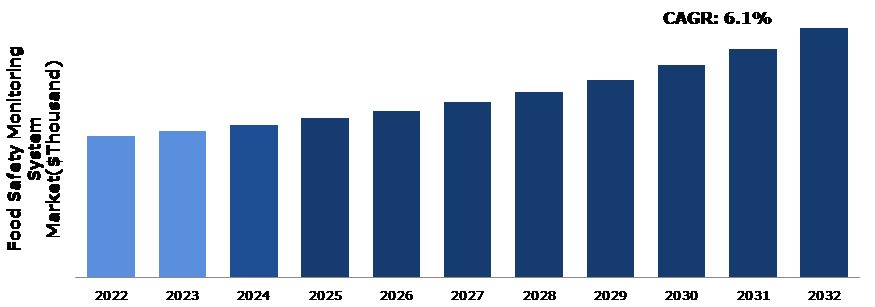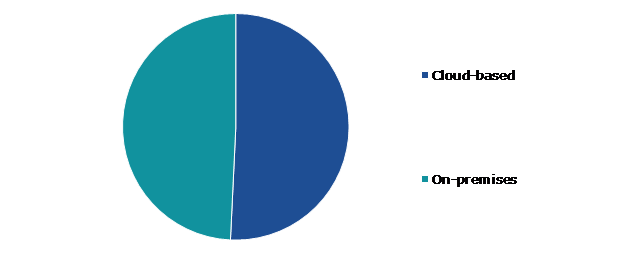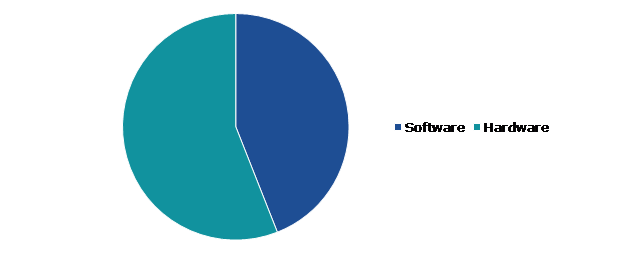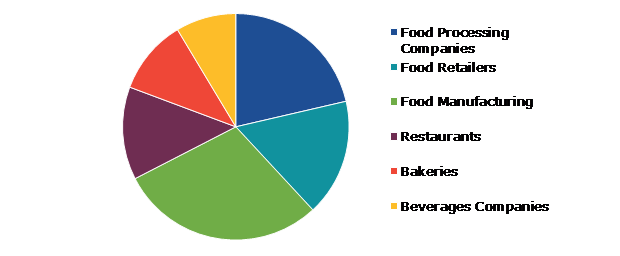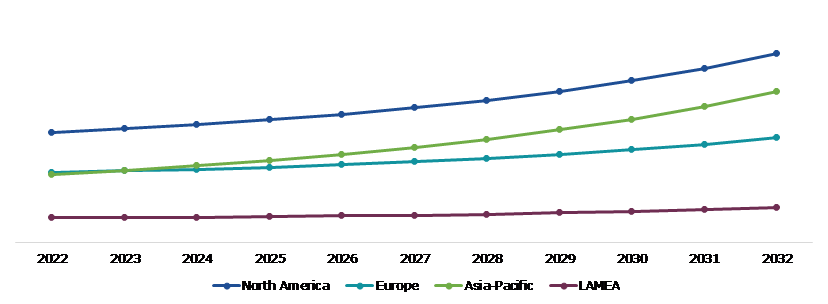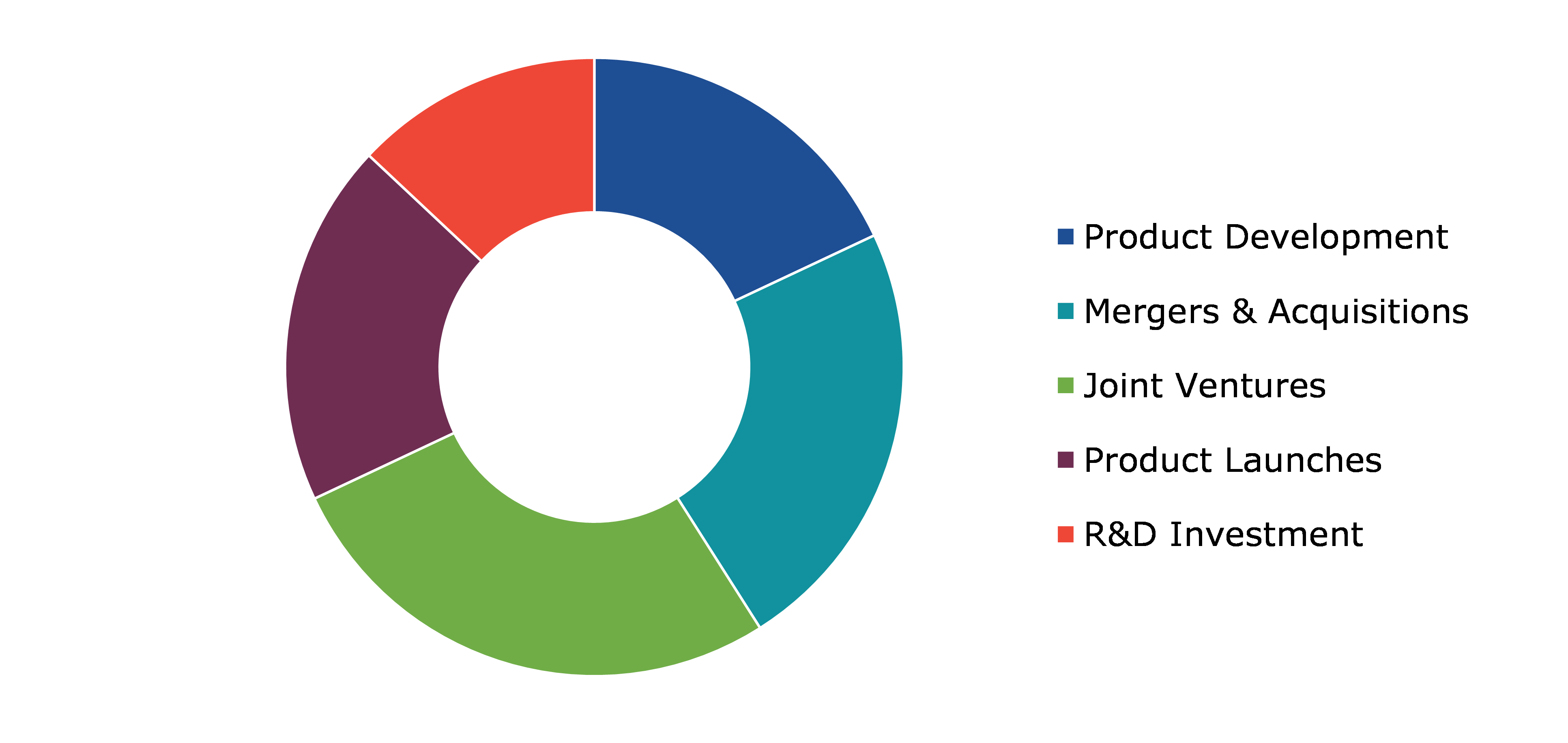Food Safety Monitoring System Market Report
RA09229
Food Safety Monitoring System Market by Technology (Cloud and On-Premises), Component (Software, and Hardware), End-user (Food Processing Companies, Food Retailers, Food Manufacturing, Restaurants, Bakeries, and Beverages Companies), and Region (North America, Europe, Asia-Pacific, and LAMEA): Global Opportunity Analysis and Industry Forecast, 2023-2032
Food Safety Monitoring System Overview
A food safety monitoring system is a complete framework that employs technology and protocols to track, assess, and ensure the protection of foods during the production, distribution, and consumption stages. It entails real-time data collection, analysis, and regulatory compliance to become conscious of and mitigate potential hazards, improving food security and public health. Food safety monitoring system is a wide-ranging framework of procedures, technologies, and protocols designed to monitor, analyze, and guarantee the protection of food products across the food supply chain. The food safety monitoring system to be aware of and reduce any risks, pollutants, and risks that may also harm the safety and integrity of food, eventually protecting customers' health. It often involves a range of methods, such as inspections, testing, facts analysis, traceability, and regulatory compliance, to maintain and acknowledge food security standards from manufacturing and processing to distribution and consumption.
Global Food Safety Monitoring System Market Analysis
The global food safety monitoring system market size was $36,074.5 thousand in 2022 and is predicted to grow with a CAGR of 6.1%, by generating a revenue of $63,492.3 thousand by 2032.
Source: Research Dive Analysis
COVID-19 Impact on the Global Food Safety Monitoring System Market
The food safety monitoring device market had a significant Impact due to the COVID-19 pandemic. The food safety monitoring system market has witnessed unprecedented growth as companies prioritized stringent security measures. The demand for advanced monitoring solutions surged, ensuring adherence to hygiene protocols and safeguarding public health. Robust structures equipped with real-time records analytics are becoming essential, fostering a resilient and secure food supply chain in the face of international health challenges.
The food safety monitoring system market post-COVID-19 has witnessed accelerated growth, driven by improved focus and stringent regulations. The pandemic led to an increase in the focus on food safety, prompting a surge in demand for superior monitoring solutions. Companies are strategically investing in cutting-edge technologies like blockchain and Industrial Internet of Things (IIoT) to enable real-time tracking and ensure the security and high-quality standards of food supply chains. This increased emphasis on food safety measures is predicted to sustain market growth as the industry adapts to a new normal in the post-pandemic world.
Rapid Shift toward Food Safety and Hygiene to Reduce Food Waste to Drive Market Growth
The food industry is undergoing rapid change with a strong emphasis on ensuring food safety and hygiene to tackle the issue of food waste. Due to increasing awareness and concerns about health, consumers, and companies are placing a greater focus on maintaining the quality and security of food products. This shift is driven by the recognition that proper protection measures not only protect consumers but also contribute to decrease in food waste. As people increasingly prioritize environmental sustainability and recognize the impact of food waste, there is a growing awareness regarding preventing contamination and spoilage.. This awareness has led to the extended adoption of technologies and practices that monitor and maintain the protection of food throughout the supply chain. From farm to fork, stakeholders are investing in measures like advanced packaging, storage, and transportation systems to ensure that food remains safe for consumption. Governments and regulatory bodies are also playing a pivotal role by implementing stringent standards to enforce food safety practices. Therefore, the movement towards food safety is not only about protecting health, but also about preserving sources and reducing the environmental impact of waste food.
Lack of Prevention Infrastructure in Food Processing to Restrain the Market Growth
The food safety monitoring system market faces a hindrance due to the lack of preventive infrastructure in food processing, restraining its growth. Insufficient infrastructure in the food processing sector poses a risk to food safety, as preventive measures are essential in avoiding contamination and ensuring product integrity. Insufficient monitoring and control mechanisms also lead to compromised meal quality and safety problems throughout the supply chain. To overcome this limitation, there is a rising need for investments in robust infrastructure, such as advanced processing technologies, first-rate management systems, and training programs. Addressing these gaps is critical to fostering a safer and more dependable food processing industry, thereby advertising the food safety monitoring system market growth.
Rising Demand for Food Safety in Online Retailing to Drive Excellent Opportunities
The increase in online food retailing has opened up new opportunities for the food safety monitoring system market players. As consumers increasingly turn to digital platforms for their food purchases, ensuring the safety of products sold online becomes paramount. This shift in consumer behavior creates excellent possibilities for testing services to play a crucial role in maintaining the safety and quality of food products in the digital marketplace. Online food retailing introduces unique challenges in terms of storage, transportation, and handling of food products. With the supply chain extending to a variety of regions and involving multiple stakeholders, the need for effective food protection monitoring becomes more evident. Testing services are expected to play a pivotal role in this scenario by conducting rigorous assessments to verify the safety and quality of products sold through digital platforms. As consumers demand transparency and trust in their online food purchases, testing services offer a reliable means to validate compliance with safety standards. This not only safeguards consumer health but also enhances the reputation of online food retailers. The food security monitoring system market is poised to capitalize on these opportunities, providing innovative solutions to address the evolving landscape of food retailing and ensuring that the digital marketplace maintains the perfect requirements of food security and quality.
Global Food Safety Monitoring System Market Share, by Technology, 2022
Source: Research Dive Analysis
The cloud-based sub-segment accounted for the highest market share in 2022. Leveraging cloud technology offers advantages, such as facilitating real-time information access, storage, and analysis. Cloud-based solutions enable seamless collaboration and communication across the food supply chain, enhancing the monitoring and management of food protection measures. This strategy ensures swift response to potential risks, minimizing the effect of foodborne incidents. The scalability and flexibility of cloud-based systems additionally empower organizations to adapt rapidly to evolving regulatory requirements. Therefore, the integration of cloud technology in food safety monitoring systems not only enhances effectiveness but also contributes extensively to the overall improvement and growth of the market.
Global Food Safety Monitoring System Market Share, by Component, 2022
Source: Research Dive Analysis
The hardware sub-segment accounted for the highest market share in 2022. The hardware segment in the food safety monitoring system market encompasses essential components for effective monitoring and control. This includes sensors, detectors, and devices designed to become aware regarding contaminants, pathogens, and different potential hazards in the food supply chain. Robust hardware solutions ensure real-time data collection and analysis, facilitating immediate response to security threats. Advanced technologies such as IoT-enabled devices enhance traceability and monitoring capabilities. The hardware phase performs a pivotal function in fortifying the ordinary food safety infrastructure, providing reliability and accuracy in identifying risks and retaining the integrity of food products from production to consumption.
Global Food Safety Monitoring System Market Share, by End-user, 2022
Source: Research Dive Analysis
The food manufacturing sub-segment accounted for the highest market share in 2022. The food production industry's improved emphasis on food safety and regulatory compliance is using state-of-the-art monitoring technologies. Companies are step-by-step investing in technology that guarantees food product traceability and first-class quality throughout the manufacturing process. This emphasis is inspired not just by regulatory obligations, but also through customer demand for safe, high-quality food. As a result, the food manufacturing enterprise is a key factor driving the growth of the food safety monitoring system market, resulting in significant opportunities for innovation and market competitors.
Global Food Safety Monitoring System Market Size & Forecast, by Region, 2022-2032 ($Thousand)
Source: Research Dive Analysis
The North American food safety monitoring system market share generated the highest revenue in 2022. Stringent regulatory frameworks and an increase in awareness regarding foodborne diseases are compelling organizations to invest in advanced monitoring systems. The region's state-of-the-art infrastructure and technological advancements further facilitate the adoption of modern options for real-time monitoring and traceability during the food supply chain. In addition, patron demand for transparency and the assurance of safe, first-rate food products are significant contributors to the food safety monitoring system market growth. Therefore, the convergence of regulatory initiatives, technological advancements, and consumer expectations is fostering a thriving market for food safety monitoring system in North America.
Competitive Scenario in the Global Food Safety Monitoring System Market
Investment and agreement are common strategies followed by major market players. One of the leading market players in the industry is Hygiena. In October 2022, Hygiena launched SureTrend Cloud, an advanced Software as a Solution (SaaS) offering. Tailored for food safety and quality managers, this tool offers robust data-driven insights. With its tiered structure, SureTrend Cloud empowers managers to make informed decisions, enhancing overall food safety measures. The platform reflects Hygiena's commitment toward delivering powerful solutions that elevate data analysis for improved food safety and quality management.
Source: Research Dive Analysis
Some of the companies operating in the food safety monitoring system market analysis are SGS SA, RJ Hill Laboratories Ltd., DuPont, Intertek Group PLC, Danaher Corporation, SAP, AsureQuality Ltd., SecureMetric Technology, IBM, and Bureau Veritas SA
| Aspect | Particulars |
| Historical Market Estimations | 2020-2021 |
| Base Year for Market Estimation | 2022 |
| Forecast Timeline for Market Projection | 2023-2032 |
| Geographical Scope | North America, Europe, Asia-Pacific, and LAMEA |
| Segmentation by Technology |
|
| Segmentation by Component |
|
|
Segmentation by End-user
|
|
| Key Companies Profiled |
|
Q1. What is the size of the global food safety monitoring system market?
A. The size of the global food safety monitoring system market size was over $36,074.5 thousand in 2022 and is projected to reach $63,492.3 thousand by 2032.
Q2. Which are the major companies in the food safety monitoring system market?
A. SGS SA, RJ Hill Laboratories Ltd., DuPont, and Intertek Group PLC are some of the key players in the global food safety monitoring system market.
Q3. Which region, among others, possesses greater investment opportunities in the future?
A. Asia-Pacific possesses great investment opportunities for investors in the future.
Q4. What will be the growth rate of the Asia-Pacific food safety monitoring system market?
A. The Asia-Pacific food safety monitoring system market share is anticipated to grow at 8.6% CAGR during the forecast period.
Q5. What are the strategies opted by the leading players in this market?
A. Agreement and investment are the two key strategies opted by the operating companies in this market.
Q6. Which companies are investing more on R&D practices?
A. SGS SA, RJ Hill Laboratories Ltd., DuPont, and Intertek Group PLC are the companies investing more on R&D activities for developing new products and technologies.
1. Research Methodology
1.1. Desk Research
1.2. Real time insights and validation
1.3. Forecast model
1.4. Assumptions and forecast parameters
1.5. Market size estimation
1.5.1. Top-down approach
1.5.2. Bottom-up approach
2. Report Scope
2.1. Market definition
2.2. Key objectives of the study
2.3. Report overview
2.4. Market segmentation
2.5. Overview of the impact of COVID-19 on global food safety monitoring system market
3. Executive Summary
4. Market Overview
4.1. Introduction
4.2. Growth impact forces
4.2.1. Drivers
4.2.2. Restraints
4.2.3. Opportunities
4.3. Market value chain analysis
4.3.1. List of raw material suppliers
4.3.2. List of manufacturers
4.3.3. List of distributors
4.4. Innovation & sustainability matrices
4.4.1. Technology matrix
4.4.2. Regulatory matrix
4.5. Porter’s five forces analysis
4.5.1. Bargaining power of suppliers
4.5.2. Bargaining power of consumers
4.5.3. Threat of substitutes
4.5.4. Threat of new entrants
4.5.5. Competitive rivalry intensity
4.6. PESTLE analysis
4.6.1. Political
4.6.2. Economical
4.6.3. Social
4.6.4. Technological
4.6.5. Legal
4.6.6. Environmental
4.7. Impact of COVID-19 on food safety monitoring system market
4.7.1. Pre-covid market scenario
4.7.2. Post-covid market scenario
5. Food Safety Monitoring System Market Analysis, by Technology
5.1. Overview
5.2. Cloud
5.2.1. Definition, key trends, growth factors, and opportunities
5.2.2. Market size analysis, by region, 2022-2032
5.2.3. Market share analysis, by country, 2022-2032
5.3. On-Premises
5.3.1. Definition, key trends, growth factors, and opportunities
5.3.2. Market size analysis, by region, 2022-2032
5.3.3. Market share analysis, by country, 2022-2032
5.4. Research Dive Exclusive Insights
5.4.1. Market attractiveness
5.4.2. Competition heatmap
6. Food Safety Monitoring System Market Analysis, by Component
6.1. Software
6.1.1. Definition, key trends, growth factors, and opportunities
6.1.2. Market size analysis, by region, 2022-2032
6.1.3. Market share analysis, by country, 2022-2032
6.2. Hardware
6.2.1. Definition, key trends, growth factors, and opportunities
6.2.2. Market size analysis, by region, 2022-2032
6.2.3. Market share analysis, by country, 2022-2032
6.3. Research Dive Exclusive Insights
6.3.1. Market attractiveness
6.3.2. Competition heatmap
7. Food Safety Monitoring System Market Analysis, by End-user
7.1. Food Processing Companies
7.1.1. Definition, key trends, growth factors, and opportunities
7.1.2. Market size analysis, by region, 2022-2032
7.1.3. Market share analysis, by country, 2022-2032
7.2. Food Retailers
7.2.1. Definition, key trends, growth factors, and opportunities
7.2.2. Market size analysis, by region, 2022-2032
7.2.3. Market share analysis, by country, 2022-2032
7.3. Food Manufacturing
7.3.1. Definition, key trends, growth factors, and opportunities
7.3.2. Market size analysis, by region, 2022-2032
7.3.3. Market share analysis, by country, 2022-2032
7.4. Restaurants
7.4.1. Definition, key trends, growth factors, and opportunities
7.4.2. Market size analysis, by region, 2022-2032
7.4.3. Market share analysis, by country, 2022-2032
7.5. Bakeries
7.5.1. Definition, key trends, growth factors, and opportunities
7.5.2. Market size analysis, by region, 2022-2032
7.5.3. Market share analysis, by country, 2022-2032
7.6. Beverages Companies
7.6.1. Definition, key trends, growth factors, and opportunities
7.6.2. Market size analysis, by region, 2022-2032
7.6.3. Market share analysis, by country, 2022-2032
7.7. Research Dive Exclusive Insights
7.7.1. Market attractiveness
7.7.2. Competition heatmap
8. Food Safety Monitoring System Market, by Region
8.1. North America
8.1.1. U.S.
8.1.1.1. Market size analysis, by Technology, 2022-2032
8.1.1.2. Market size analysis, by Component, 2022-2032
8.1.1.3. Market size analysis, by End-user, 2022-2032
8.1.2. Canada
8.1.2.1. Market size analysis, by Technology, 2022-2032
8.1.2.2. Market size analysis, by Component, 2022-2032
8.1.2.3. Market size analysis, by End-user, 2022-2032
8.1.3. Mexico
8.1.3.1. Market size analysis, by Technology, 2022-2032
8.1.3.2. Market size analysis, by Component, 2022-2032
8.1.3.3. Market size analysis, by End-user, 2022-2032
8.1.4. Research Dive Exclusive Insights
8.1.4.1. Market attractiveness
8.1.4.2. Competition heatmap
8.2. Europe
8.2.1. Germany
8.2.1.1. Market size analysis, by Technology, 2022-2032
8.2.1.2. Market size analysis, by Component, 2022-2032
8.2.1.3. Market size analysis, by End-user, 2022-2032
8.2.2. UK
8.2.2.1. Market size analysis, by Technology, 2022-2032
8.2.2.2. Market size analysis, by Component, 2022-2032
8.2.2.3. Market size analysis, by End-user, 2022-2032
8.2.3. France
8.2.3.1. Market size analysis, by Technology, 2022-2032
8.2.3.2. Market size analysis, by Component, 2022-2032
8.2.3.3. Market size analysis, by End-user, 2022-2032
8.2.4. Spain
8.2.4.1. Market size analysis, by Technology, 2022-2032
8.2.4.2. Market size analysis, by Component, 2022-2032
8.2.4.3. Market size analysis, by End-user, 2022-2032
8.2.5. Italy
8.2.5.1. Market size analysis, by Technology, 2022-2032
8.2.5.2. Market size analysis, by Component, 2022-2032
8.2.5.3. Market size analysis, by End-user, 2022-2032
8.2.6. Rest of Europe
8.2.6.1. Market size analysis, by Technology, 2022-2032
8.2.6.2. Market size analysis, by Component, 2022-2032
8.2.6.3. Market size analysis, by End-user, 2022-2032
8.2.7. Research Dive Exclusive Insights
8.2.7.1. Market attractiveness
8.2.7.2. Competition heatmap
8.3. Asia-Pacific
8.3.1. China
8.3.1.1. Market size analysis, by Technology, 2022-2032
8.3.1.2. Market size analysis, by Component, 2022-2032
8.3.1.3. Market size analysis, by End-user, 2022-2032
8.3.2. Japan
8.3.2.1. Market size analysis, by Technology, 2022-2032
8.3.2.2. Market size analysis, by Component, 2022-2032
8.3.2.3. Market size analysis, by End-user, 2022-2032
8.3.3. India
8.3.3.1. Market size analysis, by Technology, 2022-2032
8.3.3.2. Market size analysis, by Component, 2022-2032
8.3.3.3. Market size analysis, by End-user, 2022-2032
8.3.4. Australia
8.3.4.1. Market size analysis, by Technology, 2022-2032
8.3.4.2. Market size analysis, by Component, 2022-2032
8.3.4.3. Market size analysis, by End-user, 2022-2032
8.3.5. South Korea
8.3.5.1. Market size analysis, by Technology, 2022-2032
8.3.5.2. Market size analysis, by Component, 2022-2032
8.3.5.3. Market size analysis, by End-user, 2022-2032
8.3.6. Rest of Asia-Pacific
8.3.6.1. Market size analysis, by Technology, 2022-2032
8.3.6.2. Market size analysis, by Component, 2022-2032
8.3.6.3. Market size analysis, by End-user, 2022-2032
8.3.7. Research Dive Exclusive Insights
8.3.7.1. Market attractiveness
8.3.7.2. Competition heatmap
8.4. LAMEA
8.4.1. Brazil
8.4.1.1. Market size analysis, by Technology, 2022-2032
8.4.1.2. Market size analysis, by Component, 2022-2032
8.4.1.3. Market size analysis, by End-user, 2022-2032
8.4.2. Saudi Arabia
8.4.2.1. Market size analysis, by Technology, 2022-2032
8.4.2.2. Market size analysis, by Component, 2022-2032
8.4.2.3. Market size analysis, by End-user, 2022-2032
8.4.3. UAE
8.4.3.1. Market size analysis, by Technology, 2022-2032
8.4.3.2. Market size analysis, by Component, 2022-2032
8.4.3.3. Market size analysis, by End-user, 2022-2032
8.4.4. South Africa
8.4.4.1. Market size analysis, by Technology, 2022-2032
8.4.4.2. Market size analysis, by Component, 2022-2032
8.4.4.3. Market size analysis, by End-user, 2022-2032
8.4.5. Rest of LAMEA
8.4.5.1. Market size analysis, by Technology, 2022-2032
8.4.5.2. Market size analysis, by Component, 2022-2032
8.4.5.3. Market size analysis, by End-user, 2022-2032
8.4.6. Research Dive Exclusive Insights
8.4.6.1. Market attractiveness
8.4.6.2. Competition heatmap
9. Competitive Landscape
9.1. Top winning strategies, 2022
9.1.1. By strategy
9.1.2. By year
9.2. Strategic overview
9.3. Market share analysis, 2022
10. Company Profiles
10.1. SGS SA
10.1.1. Overview
10.1.2. Business segments
10.1.3. Product portfolio
10.1.4. Financial performance
10.1.5. Recent developments
10.1.6. SWOT analysis
10.2. RJ Hill Laboratories Ltd.
10.2.1. Overview
10.2.2. Business segments
10.2.3. Product portfolio
10.2.4. Financial performance
10.2.5. Recent developments
10.2.6. SWOT analysis
10.3. DuPont
10.3.1. Overview
10.3.2. Business segments
10.3.3. Product portfolio
10.3.4. Financial performance
10.3.5. Recent developments
10.3.6. SWOT analysis
10.4. Intertek Group PLC
10.4.1. Overview
10.4.2. Business segments
10.4.3. Product portfolio
10.4.4. Financial performance
10.4.5. Recent developments
10.4.6. SWOT analysis
10.5. Danaher Corporation
10.5.1. Overview
10.5.2. Business segments
10.5.3. Product portfolio
10.5.4. Financial performance
10.5.5. Recent developments
10.5.6. SWOT analysis
10.6. SAP
10.6.1. Overview
10.6.2. Business segments
10.6.3. Product portfolio
10.6.4. Financial performance
10.6.5. Recent developments
10.6.6. SWOT analysis
10.7. AsureQuality Ltd.
10.7.1. Overview
10.7.2. Business segments
10.7.3. Product portfolio
10.7.4. Financial performance
10.7.5. Recent developments
10.7.6. SWOT analysis
10.8. SecureMetric Technology
10.8.1. Overview
10.8.2. Business segments
10.8.3. Product portfolio
10.8.4. Financial performance
10.8.5. Recent developments
10.8.6. SWOT analysis
10.9. IBM
10.9.1. Overview
10.9.2. Business segments
10.9.3. Product portfolio
10.9.4. Financial performance
10.9.5. Recent developments
10.9.6. SWOT analysis
10.10. Bureau Veritas SA
10.10.1. Overview
10.10.2. Business segments
10.10.3. Product portfolio
10.10.4. Financial performance
10.10.5. Recent developments
10.10.6. SWOT analysis
Personalize this research
- Triangulate with your own data
- Request your format and definition
- Get a deeper dive on a specific application, geography, customer or competitor
- + 1-888-961-4454 Toll - Free
- support@researchdive.com

